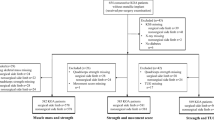Summary
Patients with osteoarthrosis suffer from disability and pain. We measured isokinetic and isometric peak torque in 20 women with gonarthrosis (GA) and in 26 healthy controls. Relationships between muscle strength, walking and stair climbing time, pain level and pain disability scores as assessed by the patients using an extensive questionnaire, radiological changes and subchondral sclerosis expressed as bone mineral density (BMD, g/cm2) of the proximal tibia were studied.
Precision errors of the torque measurements in both GA patients and controls were approximately 6%. In the GA patients, isokinetic and isometric quadriceps strength was reduced by 40 and 15% (p<0.01) respectively, and walking and stair climbing time was increased by 30% (p<0.005). Isokinetic strength was a better predictor of pain level and pain disability scores than isometric strength and radiological stage. Walking time and stair climbing time were not associated with quadriceps strength, pain level, pain disability scores or radiological changes. Subchondral BMD was not predictive of pain.
The study suggests that quadriceps strength assessed by isokinetic dynamometry in GA is a reliable measurement. Isokinetic strength was pronouncedly reduced compared to isometric strength and was a more important predictor of pain and pain disability than isometric strength. These findings should be taken into consideration when planning exercise studies and programmes in GA.
Similar content being viewed by others
References
Ekdahl, C., Andersson, S.I., Svensson, B. Muscle function of the lower extremities in rheumatoid arthritis and osteoarthrosis. J Clin Epidemiol 1989, 42, 947–954.
Fisher, N.M., Pendergast, D.R., Gresham, G., Calkins, E. Muscle rehabilitation: Its effect on muscular and functional performance of patients with knee osteoarthritis. Arch Phys Med Rehabil 1991, 72, 367–374.
Chamberlain, M.A., Care, G., Harfield, B. Physiotherapy in osteoarthrosis of the knees. A controlled trial of hospital versus home exercises. Int Rehab Med 1982, 4, 101–106.
Nordesjö, L., Nordgren, B., Wigren, A., Kolstad, K. Isometric strength and endurance in patients with severe rheumatoid arthritis or osteoarthrosis in the knee joints. Scan J Rheumatol 1983, 12, 152–156.
Kellgren, J.H. Pain in osteoarthritis. J Rheumatol 1983, 10, 108–109.
Kellgren, J.H., Lawrence, J.S. Radiologic assessment of osteoarthritis. Ann Rheum Dis 1957, 16, 494–501.
Danneskiold-Samsoe, B., Kofod, V., Munter, J., Grimby, J. Muscle strength and functional capacity in 78–81-year-old men and women. Eur J Appl Physiol 1984, 52, 310–314.
Mawdsley, R.H., Knapik, J.J. Comparison of isokinetic measurements with test repetitions. Phys Ther 1982, 62, 169–172.
Madsen, O.R., Schaadt, O., Bliddal, H., Egsmose, C., Sylvest, J. Relationship between quadriceps strength and bone mineral density of the proximal tibia and distal forearm in women. J Bone Miner Res 1993, 8, 1439–1444.
Gransberg, L., Knutsson, E. Determination of dynamic muscle strength in man with acceleration controlled isokinetic movements. Acta Physiol Scand 1983, 119, 317–320.
Madsen, O.R., Schaadt O., Bliddal, H., Egsmose, C., Sylvest, J. Bone mineral distribution of the proximal tibia in gonarthrosis assessed in vivo by photon absorption. Osteoarthritis and Cartilage 1994, 2, 141–147.
Fairbank, J.C.T., Couper, J., Davies, J.B., O'Brian, J.P. The Oswestry Low Back Pain Disability Questionnaire. Physiotherapy 1980, 66, 271–273.
Kirkwood, B.R. Essentials in Medical Statistics. Blackwell Scientific Publications, 1988. London, UK.
SPSS/PC+StatisticsTM 4.0 [manual]. SPSS Inc, 1990. Chicago, IL 60611, USA.
Giles, B., Henke, P., Edmunds, J., McNeil, D. Reproducibility of isokinetic muscle strength measurements in normal and in arthritic individuals. Scand J Rehab Med 1990, 22, 93–99.
Danneskiold-Samsoe, B., Grimby, G. Isokinetic and isometric muscle strength in patients with rheumatoid arthritis. The relationship to clinical parameters and the influence of corticosteroids. Clin Rheumatol 1986, 5, 459–468.
Lankhorst, G.J., Van de Stadt, R.J., Van der Korst, J.K. The relationships of functional capacity, pain, and isometric and isokinetic torque in osteoarthrosis of the knee. Scan J Rehab Med 1985, 17, 167–172.
Johnson, T. Age-related differences in isometric and dynamic strength and endurance. Phys Ther 1982, 62, 985–989.
Felson, D.T., Anderson, J.J., Naimark, A., Walker, A.M., Meenan, R.P. Obesity and knee osteoarthritis. The Framingham study. Ann Intern Med 1988, 109, 18–24.
Dastur, D.K., Gagrat, B.M., Marghane, D.K. Human muscle in disuse atrophy. Neuropathol Appl Neurobiol 1979, 5, 85–91.
Glasberg, M.R., Glasberg, J.R., Jones, R.E. Muscle pathology in total knee replacement for severe osteoarthritis: A histochemical and morphometric study. Henry Ford Hosp Med J 1986, 34, 37–40.
Harries, U.J., Bassey, E.J. Torque-velocity relationships for the knee extensors in women in their 3rd and 7th decades. Eur J Appl Physiol 1990, 60, 187–190.
Grimby, G., Aniansson, A., Zetterberg, C., Saltin, B. Is there a change in relative fibre composition with age? Clin Physiol 1984, 4, 189–194.
Stokes, M., Young, A. The contribution of reflex inhibition to arthrogenous muscle weakness. Clin Science 1984, 67, 7–14.
Hurley, M.V., Newham, D.J. The influence of arthrogenous muscle inhibition on quadriceps rehabilitation of patients with early, unilateral osteoarthritic knees. Br J Rheum 1993, 32, 127–131.
Shakespeare, D.T., Stokes, M., Sherman, K.P. Reflex inhibition in the quadriceps after menisctomi: Lack of association with pain. Clin Physiol 1985, 5 137–144.
Dekker, J., Boot, B., Van der Woude, L.H.V., Bijlsma, J.W.J. Pain and disability in osteoarthritis: A review of biobehavioral mechanisms. J Behav Med 1992, 15, 189–214.
Davis, M.A. Sex differences in reporting osteoarthrotic symptoms: A sociomedical approach. J Health Soc Behav 1981, 22, 298–310.
Massadaro, L., Watt, I., Cushnaghan, J., Dieppe, P. Osteoarthrosis of the knee joint: An eight year prospective study. Ann Rheum Dis 1989, 48, 893–897.
Author information
Authors and Affiliations
Rights and permissions
About this article
Cite this article
Madsen, O.R., Bliddal, H., Egsmose, C. et al. Isometric and isokinetic quadriceps strength in gonarthrosis; Inter-relations between quadriceps strength, walking ability, radiology, subchondral bone density and pain. Clin Rheumatol 14, 308–314 (1995). https://doi.org/10.1007/BF02208344
Received:
Revised:
Accepted:
Issue Date:
DOI: https://doi.org/10.1007/BF02208344




